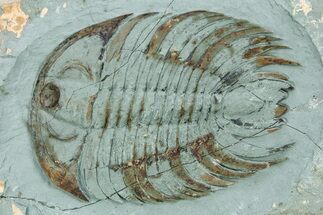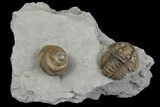This Specimen has been sold.
Flexicalymene Trilobite Fossil and Gastropod - Ohio
Here is a Flexicalymene retrorsa trilobite presented on the same piece of shale as a Cyclonema bilix gastropod from the Arnheim Formation of Ohio. The trilobite is 1" long and the gastropod is .8" wide, both atop a slab of shale that measures 3.8 x 2.7". Both specimens were prepared using air abrasives under microscope and the gastropod has been mounted on the rock which contained the trilobite.
It comes with an acrylic display stand.
It comes with an acrylic display stand.
About Flexicalymene Trilobites
Flexicalymene is a genus of trilobites of the order Phacopida, suborder Calymenina. These ancient arthropods are an index fossil of the Ordovician, between 488-443 million years ago. The graceful articulation, especially of the thorax segments, demonstrates that this distant precursor of insects is deserving of its delightful name.
Flexicalymene is often found enrolled, seemingly to protect its softer underside from threats on a sea floor teeming with ancient life and increasingly complex predators. Sealing itself inside the hard carapace may be a protective maneuver, or it may simply be the pose of death.
Two species of Flexicalymene are found in the Richmond Formation of Ohio, but in different sub-units. Flexicalymene meeki has small genal spines and is the more common of the two, often coming from Mt Orab, Ohio. These spines are absent in the other species, F. retrorsa. The F. retrorsa cephalon is more rounded, while the F. meeki cephalon is pronounced. They were also denizens at different locales. Calymene, meaning “beautiful crescent”, should not be confused with Flexicalymene: it is a separate genus.
Flexicalymene meeki has been studied for its abundant perforations. The perforations have been interpreted as the loci of sensory hairs: these loci occur in many sizes, and are an interesting feature of exoskeleton microfeatures. They are concentrated on areas most likely to contact other objects in the environment.
Flexicalymene is a genus of trilobites of the order Phacopida, suborder Calymenina. These ancient arthropods are an index fossil of the Ordovician, between 488-443 million years ago. The graceful articulation, especially of the thorax segments, demonstrates that this distant precursor of insects is deserving of its delightful name.
Flexicalymene is often found enrolled, seemingly to protect its softer underside from threats on a sea floor teeming with ancient life and increasingly complex predators. Sealing itself inside the hard carapace may be a protective maneuver, or it may simply be the pose of death.
Two species of Flexicalymene are found in the Richmond Formation of Ohio, but in different sub-units. Flexicalymene meeki has small genal spines and is the more common of the two, often coming from Mt Orab, Ohio. These spines are absent in the other species, F. retrorsa. The F. retrorsa cephalon is more rounded, while the F. meeki cephalon is pronounced. They were also denizens at different locales. Calymene, meaning “beautiful crescent”, should not be confused with Flexicalymene: it is a separate genus.
Flexicalymene meeki has been studied for its abundant perforations. The perforations have been interpreted as the loci of sensory hairs: these loci occur in many sizes, and are an interesting feature of exoskeleton microfeatures. They are concentrated on areas most likely to contact other objects in the environment.
Gastropods, or snails, have been around since the Late Cambrian period. The class Gastropoda contains a vast total of named species, second only to the insects in overall number. There are 611 known families of gastropods, of which 202 families are extinct and appear only in the fossil record.
SPECIES
Flexicalymene retorsa & Cyclonema bilix
LOCATION
Mt. Orab, Ohio
FORMATION
Arnheim Formation
SIZE
1" Trilobite on 3.8 x 2.7" rock
CATEGORY
SUB CATEGORY
ITEM
#136965
We guarantee the authenticity of all of our specimens.
 Reviews
Reviews













